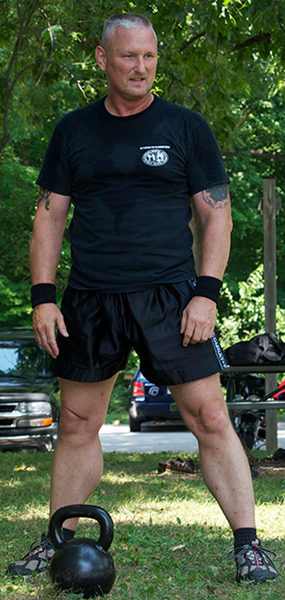
Dragon Door: How did you originally find kettlebells?
Kim Vigsbo: I've been a Krav Maga instructor for most of my life. One day I saw these two things sitting on the floor in a Krav Maga studio. I didn't know what they were, but picked them up and realized they were 35 and 40lb weights. I had no idea what they were even called at that point.
I tried some different things with them, and realized they felt different than dumbbells—they kept pulling on my muscles! I thought they'd be especially useful for Krav Maga which requires—among other things—good, strong forearms. I found out that they were kettlebells and started working with them in 2005. At the same facility, I also found one of the first Hardstyle catalogs. At that time, I had a shoulder injury, but you know the story, "I had bad shoulders, and started lifting kettlebells, then all of a sudden my shoulders came back." I couldn’t lift my left arm higher than shoulder level, and I couldn’t throw a hook, which is necessary in Krav Maga. So, I started doing modified military presses—not really knowing what I was doing, but it felt good.
I reached out to people who knew more and really started learning. I also found Dragon Door along with their books and videos—I got hooked. I worked with kettlebells by myself for a couple of years, because I was basically teaching and managing a Krav Maga school at that time. But when I started my own school, I decided that we needed kettlebells as part of our training. So I went to my first RKC certification in 2007, and I’ve never looked back!
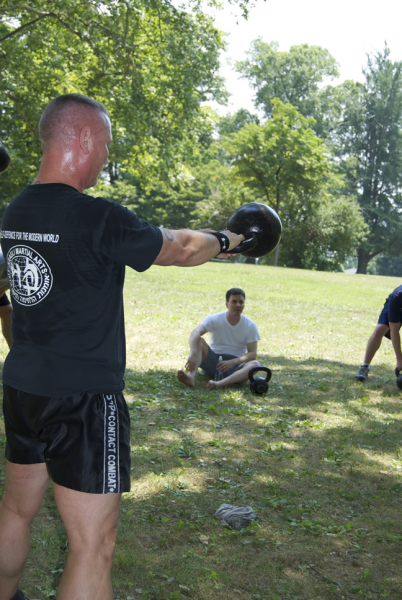
Dragon Door: Tell us about your kettlebell classes.
Kim Vigsbo: I have kettlebell-only classes a couple times a week, but I incorporate kettlebells in everything we do at our training center. We also do something we call Spartan Training for people who participate in mud and obstacle races. I had so many people ask me how to prepare for these events that I created a class for it, and it’s been very popular. In that class, we incorporate kettlebells and the HIIT protocol. Even our TRX classes start with kettlebells or use kettlebells in the class. I incorporate kettlebells into anything I get my hands on.
Dragon Door: What's the greatest advantage you've found using kettlebells?
Kim Vigsbo: Mainly, the fact that someone can hold onto the handle and get a workout. They don't have to learn specific lifts or a technically difficult move. I can pick the right kettlebell for each person in my classes. It's a very efficient tool to get people started and involved in the class, and in physical training.
New people start our classes all the time. Some have experience with kettlebells, or traditional weightlifting. Some are runners with no previous experience with weights at all. A kettlebell can help them achieve results pretty much right away—I really love that aspect of it. I have never felt that with traditional weights.
Dragon Door: What’s your favorite kettlebell exercise or drill to teach?
Kim Vigsbo: I actually love them all, but I really like the Turkish get up. It’s tough for brand new people, so I usually give them homework if they can only come to class once a week. We divide the get up into several steps and we train one at a time. People can start with something as powerful as a Turkish get up with a small weight, and get a full body workout in a matter of minutes.
I’m actually very fortunate, one of my instructors is a Physical Therapist with 20 years experience, and works with people who have injuries or limited mobility. They have actually recovered faster and safer by working with him. He uses kettlebells in his daily routine, so I am very lucky to have him as part of my team.
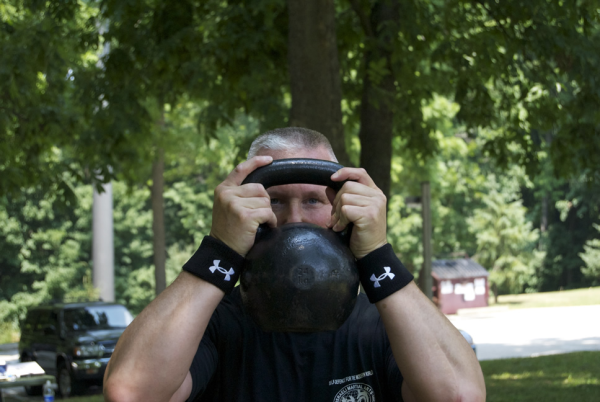
Dragon Door: Definitely. When training others for obstacle races, what kettlebell drills do you typically use?
Kim Vigsbo: I actually train all of them. This is key for races with unknown obstacles. Many people tell me after their race, "I have been running for two years. I can run like the wind all day, but ten minutes into an obstacle race, I was gassed. What’s going on?"
People need overall strength, upper body strength, core strength and control. So, we do a lot of general workouts that incorporate kettlebells. We work through the six basic RKC exercises to ensure everyone gets a full body workout. I might favor the shoulders a bit, because when people meet a 6 or 8-foot wall, they'll need shoulder strength to climb. For that, my favorite exercises are walking see-saw presses and walking swings.
Since the majority of injuries occurring at these races are ankle-based, we train to stabilize the ankles on Bosu balls, and do a lot of kettlebell goblet and front squats. We sit down in a low position and rock back and forth to strengthen the shin muscles, calf muscles, and to support the ankles.
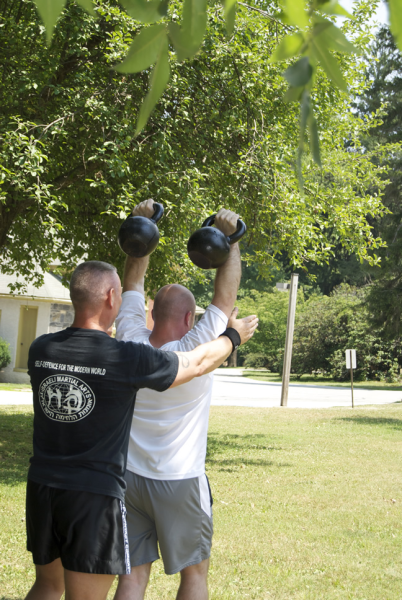
Dragon Door: Would someone who regularly trains the basic RKC six kettlebell exercises be reasonably well prepared for one of these races?
Kim Vigsbo: Absolutely, and I can say that with confidence. People who do regular kettlebell work on an RKC level will be very suitably prepared for an obstacle race. This isn't just a 5K run, the course has up to 40 obstacles. While running will get someone in good condition for running, these races are more about obstacles.
Dragon Door: How do your Krav Maga classes use kettlebells?
Kim Vigsbo: At my facility—Spartan Training Center—Hardstyle kettlebell work and Krav Maga go hand-in-hand for physical and mental training. Both require focus, safety, good form and dedication. While we do not use kettlebells as part of our actual Krav Maga classes, we do teach a full kettlebell class before each Krav Maga class.
Dragon Door: As an RKC Team Leader, what will you bring to the Dragon Door leadership team?
Kim Vigsbo: I want to add some street smarts to our training. Nothing revolutionary, but I want to show that working with kettlebells doesn’t have to be science. You need to be safe and execute good form, but I want to bring the love and joy for kettlebells.
Sometimes, we forget to have a little fun. It’s a fine balance—getting the form, being safe, and having fun. We have a lot of fun in our classes, but we’re very keen on safety. I want to be the people’s person for kettlebell work. I don't have a lot of education in sports science, but I know how to teach someone to work with kettlebells safely and have fun.
Dragon Door: That's interesting to hear from someone with your background in the Danish Special Forces, martial arts, and as a professional bodyguard.
Kim Vigsbo: I love simplicity. I am also a web designer and love keeping things simple. People understand and embrace "simple." When I’m on a bodyguard assignment, I keep it simple. And, I teach kettlebells in a simple manner. I want people to have fun, workout, and feel like they’re getting a good workout.
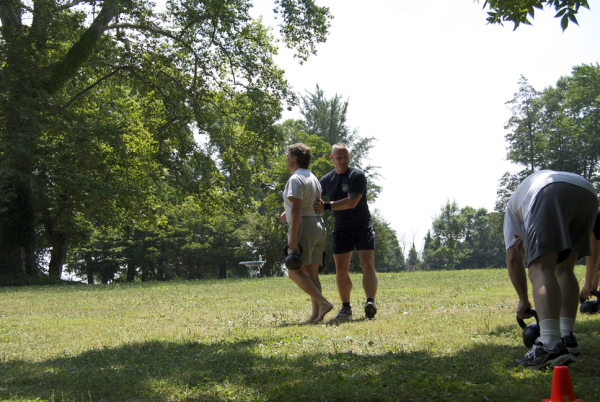
Dragon Door: What's a simple kettlebell complex or circuit that you like to lead?
Kim Vigsbo: I love putting together challenges within the framework of our kettlebell knowledge. Lately I have done a lot of double kettlebell exercises where we go for 10-15 minutes straight. An average guy will use two 16kg or two 20kg kettlebells. Women might use 8kg or more. We'll put them overhead for time, then down next to our feet and jump back for a slow push up. After getting up with our feet separated, we clean the bells and do an overhead press, then we repeat this sequence for time.
We can add moves to it, for example when coming up from the pushup we can go straight into a double snatch, or do four see-saw presses. We do everything without letting go of the bells. It's an extremely challenging full body workout.
Dragon Door: You’re the founder of Better Bodyguards, how active are you in that industry today?
Kim Vigsbo: I am still active but more in a director/instructor role since I don’t have the time to travel any more. My long-time team leader handles our European operations, I manage a small team here. I still do some local work from time to time. I have two full-time businesses now—my web design agency and my training center. The training center just moved into a bigger location with a better layout—now we have 8,000 square feet.
Dragon Door: How big are your classes?
Kim Vigsbo: They are fairly small, 10-14 people, but we have a lot of them. We have three or four instructors present every day, and group our classes by age, fitness level, or goal. Each instructor works with their group. We have a very strong TRX instructor who trains all the hard-core clients, and I usually take the new people. Lou, my PT instructor, is also TRX certified and teaches injury management.
Dragon Door: It sounds like you’ve got a lot of very exciting things going on! What’s the next thing for you?
Kim Vigsbo: In April, one of my instructors and I are going to the official Spartan Coach Certification. It’s tough, just one of requirements is doing 75 burpees in five minutes. I’m turning 54 now, and it’s not getting easier, but I’m looking forward to the challenge.
Then, I will be teaching at the RKC in Ohio in June, and we have a couple of races coming up. We're expanding the training center to have more pure kettlebell classes, and a women's only class. With the larger space, we’re going to get balance beams and ropes for the Spartan training. We already have big tires, hammers, kettlebells, ropes, etc. but we’re going to do more, along with more challenging ways to incorporate kettlebells into our workouts. Even now, we hoist them up to the ceiling with ropes—in the Spartan Race that's called a Hercules hoist.
Dragon Door: How are you training for the Spartan certification?
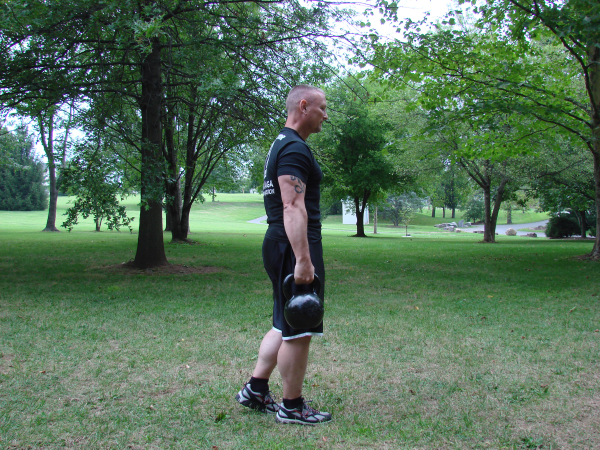
Kim Vigsbo: Last year was my strong year, and I can now military press 48kg like it’s nothing. However, I also got a little heavier because I bulked up a bit. Being an obstacle runner, bulk isn't always best, so I am in the process of trimming down considerably. I started in January at 235lbs with a goal of 190. Currently (mid-March), I weigh 210.
I want to show people that just because I'm over 50 years old, I'm not done training or taking care of myself. My fiancée is 55 years old, is one of the strongest women I know, and became vegan a while ago. I am 90-percent vegan now. I juice every day, and have tremendous energy. At the training center when people see me working with kettlebells with so much energy, they say, "Whatever it is you’re on, we want some of it," and I reply, "I’m on veggies, baby!"
I also have a disabled elbow which was shot to pieces when I was younger. It was put back together, but I have a limited range of motion and limited strength. But even though I have limited mobility in an elbow, I can still train. I want to show people that I can still do cleans, presses, everything—sometimes it might look a little odd. I’m eating and training right—there’s a reason I look the way I do at 54. I have two full-time jobs, and I can find time to eat right and train. I love working with kettlebells, and even though I have a "disability," I’m still working with them. I’m having fun, and I’m showing people that just because you have a little less mobility and strength doesn’t mean that you cannot train. In fact, you should train even more.
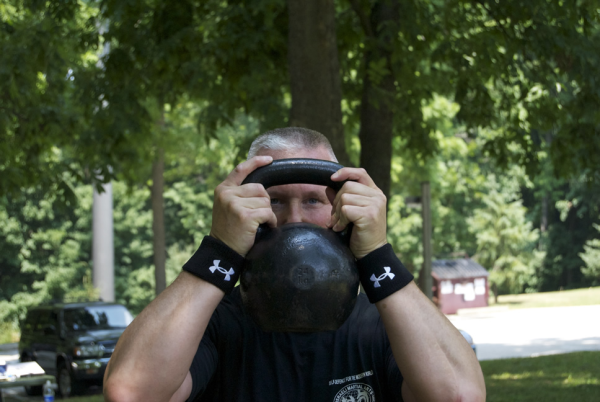 Kim Vigsbo, RKC Team Leader, trains and leads classes at his newly expanded training center, B2 Gym - in Collegeville, PA.
Kim Vigsbo, RKC Team Leader, trains and leads classes at his newly expanded training center, B2 Gym - in Collegeville, PA.
http://www.b2gym.com
(610) 620-5700